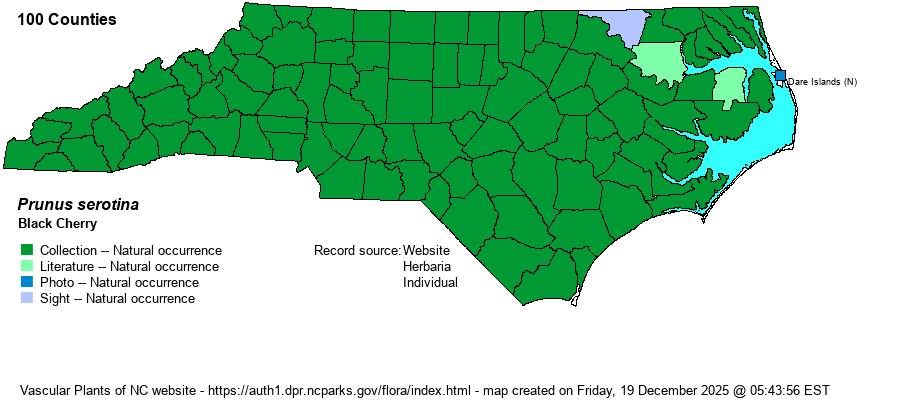| Author | Ehrhart | |
| Distribution | Occurs statewide, though it is less widespread in the far eastern counties. Certainly occurs in all 100 counties.
This tree has a very wide range, from much of Canada south to central FL, the Gulf Coast, and into Mexico. It is absent from most of the northwestern and far western U.S. states.
| |
| Abundance | Common to abundant in the Mountains, Piedmont, and most of the Coastal Plain. Much less common on barrier islands and in other tidewater counties, but still easy to find. | |
| Habitat | This species has a wide array of mesic to rich forest types, as well as edges. It is often found in coves and other rich hardwood forests in the mountains, where it can be a large tree. Downstate, it is more typical of mesic forests, bottomlands, and their edges, where it is an understory tree that does not reach the canopy. It is also widespread in old fields, thickets, and other successional habitats across its range. |
| Phenology | Blooms in spring before or just as leaves emerge, mainly in April downstate and in May in the higher mountains. Fruits in July and August. | |
| Identification | This is one of the most familiar deciduous trees in the state, known well to nearly all people who spend much time outdoors. It is a large and tall tree in the mountains, ranging up to about 90 feet tall. Downstate, it grows to about 70 feet tall, usually smaller, and is never an impressive tree east of the mountains. The bark has horizontal pale lenticels, and twigs are foul-smelling when broken; thus, experienced people can identify them in winter. The leaves are long for a plum/cherry and narrowly elliptic, wider than the tapering leaves of Fire Cherry (P. pensylvanica) and thinner than those of Carolina Laurel Cherry (P. caroliniana). If the infloresences are visible, the species is easily identified by the dangling “test-tube-cleaner looking” racemes of white flowers or dark fruits. | |
| Taxonomic Comments | Generally none, but RAB (1968) listed two varieties in the state – the nominate and common one – P. serotina var. serotina -- and P. serotina var. alabamensis, which most recent references now consider as a valid species but not present as far north as NC. Weakley (2018) and NatureServe also list varieties, with only the nominate form present in the state.
| |
| Other Common Name(s) | Wild Cherry, Wild Black Cherry | |
| State Rank | S5 | |
| Global Rank | G5 | |
| State Status | | |
| US Status | | |
| USACE-agcp | FACU link |
| USACE-emp | FACU link |

